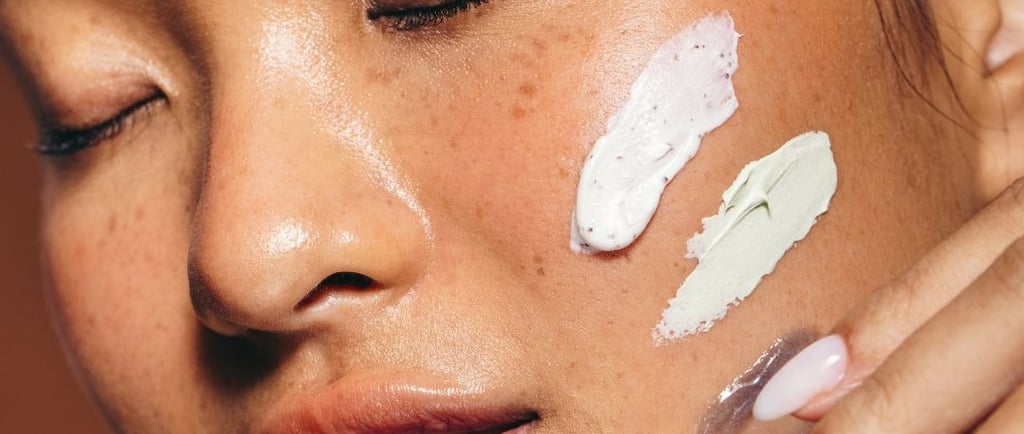Hydrating vs. Exfoliating: Which Facial Products Work Best for Your Skin?
When it comes to skincare, two essential steps often dominate discussions: hydrating and exfoliating. Both are crucial to achieving healthy, glowing skin, but they serve different purposes. Choosing the right products to incorporate into your routine can make a significant difference in how your skin looks and feels. The real question is: Should you prioritize hydration or exfoliation—or can both be integrated into your skincare routine? Let's break down what these terms mean, how they work, and how you can pick the best products for your skin type and needs.
2/24/20254 min read


When it comes to skincare, two essential steps often dominate discussions: hydrating and exfoliating. Both are crucial to achieving healthy, glowing skin, but they serve different purposes. Choosing the right products to incorporate into your routine can make a significant difference in how your skin looks and feels. The real question is: Should you prioritize hydration or exfoliation—or can both be integrated into your skincare routine? Let's break down what these terms mean, how they work, and how you can pick the best products for your skin type and needs.
Hydration: Why Your Skin Needs It
Hydration is the foundation of healthy skin. When your skin is properly hydrated, it looks plump, smooth, and radiant. On the other hand, dehydrated skin can appear dull, flaky, and rough, making it prone to irritation and fine lines.
How Hydration Works:
Hydrating products are designed to restore and lock in moisture, helping your skin maintain a balanced water content. This is especially important for skin health because moisture supports:
Skin elasticity: Hydrated skin feels more firm and supple.
Barrier function: It helps to maintain a protective barrier against environmental stressors like pollution and harsh weather.
Cell turnover: Hydrated skin is better at renewing itself and healing from damage.
Best Hydrating Ingredients:
Hyaluronic Acid: Known for its ability to hold up to 1,000 times its weight in water, this ingredient is a must-have for deep hydration and plumping.
Glycerin: A humectant that pulls moisture into the skin, leaving it soft and supple.
Aloe Vera: Naturally soothing and hydrating, ideal for calming sensitive skin.
Ceramides: Lipid molecules that help restore and maintain the skin’s moisture barrier.
Best Hydrating Products:
Hydrating Serums: These often contain high concentrations of hydrating ingredients like hyaluronic acid and glycerin.
Moisturizers: Rich, thick moisturizers help lock in hydration and maintain skin balance.
Face Mists: A quick fix for hydration, especially during the day when your skin starts to feel dry.
Sheet Masks: A deep hydrating boost for when your skin needs extra attention.
Exfoliation: The Key to Smooth, Radiant Skin
Exfoliation is the process of removing dead skin cells from the surface to reveal fresh, new skin underneath. Regular exfoliation helps your skin absorb the benefits of your other products better and promotes a smoother, more even complexion.
How Exfoliation Works:
Exfoliating removes the buildup of dead skin cells, dirt, and excess oil, which can lead to clogged pores, dullness, and acne. There are two main types of exfoliation:
Physical Exfoliation: Uses gritty scrubs, brushes, or sponges to manually slough off dead skin. These products can be abrasive and should be used gently to avoid irritation.
Chemical Exfoliation: Uses acids like AHAs (Alpha Hydroxy Acids) and BHAs (Beta Hydroxy Acids) to dissolve dead skin cells and unclog pores. AHAs, like glycolic acid, work on the surface of the skin, while BHAs, like salicylic acid, penetrate deeper into the pores, making them ideal for oily or acne-prone skin.
Best Exfoliating Ingredients:
Glycolic Acid (AHA): Helps to brighten skin and smooth fine lines by removing surface cells.
Lactic Acid (AHA): A gentler exfoliant, ideal for sensitive skin.
Salicylic Acid (BHA): Excellent for deep cleansing pores, making it perfect for acne-prone skin.
Enzymes (Papaya, Pineapple): A more natural exfoliant that gently breaks down dead skin cells without irritation.
Best Exfoliating Products:
Exfoliating Scrubs: Contain physical exfoliants, but should be used sparingly to avoid irritation.
Chemical Exfoliant Serums: Often come in low concentrations of AHAs or BHAs, perfect for weekly use.
Exfoliating Toners: Apply after cleansing, these typically contain AHAs or BHAs and help to refine skin texture over time.
Masks: A more intensive exfoliating treatment to use once or twice a week for smoother skin.


Hydrating vs. Exfoliating: How to Choose the Best Products for Your Skin
1. Know Your Skin Type
Dry Skin: If you have dry skin, hydration should be your top priority. Look for products that deeply hydrate and lock in moisture. Use gentle exfoliants once a week to avoid over-drying.
Oily or Acne-Prone Skin: People with oily skin benefit from both hydration and exfoliation. Exfoliating with a salicylic acid-based product can help keep pores clear and prevent breakouts, while a lightweight moisturizer will maintain hydration without clogging pores.
Sensitive Skin: If you have sensitive skin, opt for gentle hydrating products like aloe vera or glycerin-based moisturizers. Use mild exfoliants such as lactic acid or enzyme-based products to avoid irritation.
Combination Skin: A good balance of both hydration and exfoliation is key. Use hydrating serums or moisturizers and gentle exfoliators to target different areas (for example, exfoliating the T-zone more often).
2. When to Use Each Step
Hydration First: Hydrating products should always be used as the base of your skincare routine, followed by exfoliation when needed. Hydration will prep your skin and keep it balanced, while exfoliation will help remove buildup.
Frequency of Exfoliation: Exfoliating too often can strip the skin of natural oils and cause irritation. For most skin types, exfoliating 2-3 times a week is sufficient. If you have sensitive skin, stick to once a week.
Morning or Evening: While hydrating products can be used both in the morning and at night, exfoliating is usually better suited for evening routines to allow your skin to regenerate overnight. Plus, exfoliation can make your skin more sensitive to the sun.
Best of Both Worlds: Combining Hydration and Exfoliation
For optimal skin health, it's essential to incorporate both hydration and exfoliation into your routine, but in a balanced way. Here's how you can create a well-rounded skincare regimen:
Step 1: Start with gentle exfoliation (either physical or chemical) to remove dead skin.
Step 2: Follow with a hydrating serum to restore moisture.
Step 3: Finish with a moisturizer to lock in hydration and protect your skin.
Additionally, look for products that combine both benefits, such as exfoliating moisturizers that provide gentle exfoliation while still hydrating the skin.
Conclusion
Both hydration and exfoliation play essential roles in maintaining healthy, glowing skin, but they work best when used together in a balanced skincare routine. Hydration is crucial for maintaining moisture levels, ensuring your skin stays plump, smooth, and protected, while exfoliation helps to remove dead skin cells, reveal brighter skin, and promote healthier texture.
When choosing facial products, it's important to consider your skin type and specific concerns. Hydrate frequently, but don’t skip exfoliation—just be sure to avoid overdoing it. With the right balance, your skin will look and feel its best!
Facial Bangkok
Discover top-notch treatments for ultimate facial rejuvenation in Bangkok - Thailand.
Guide
© 2024. All rights reserved. Designed by Pimclick SEO Agency
Article
